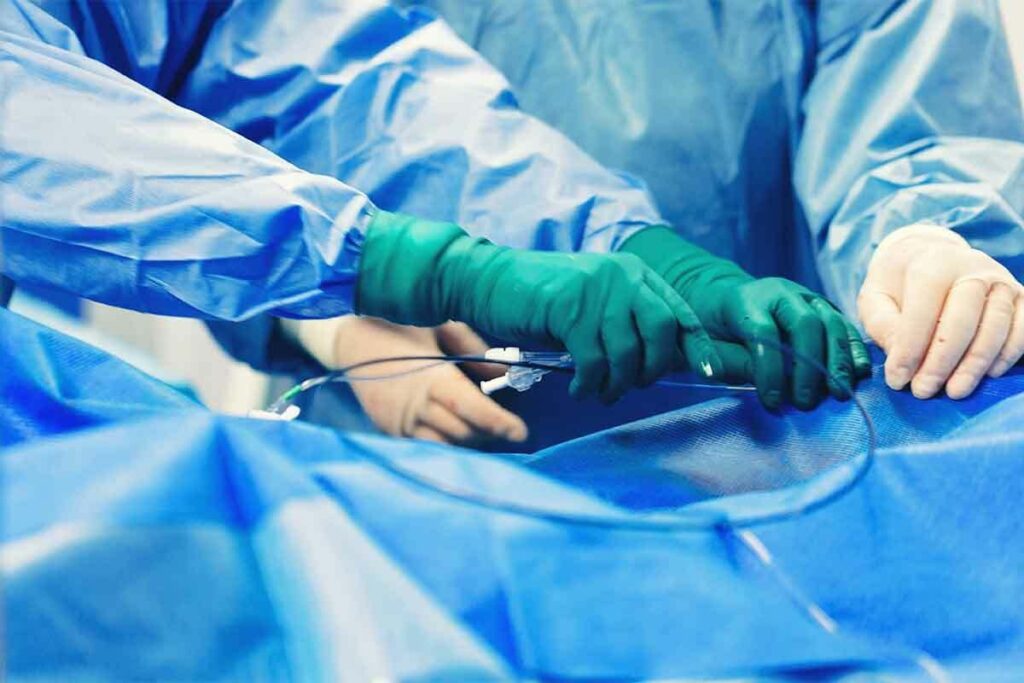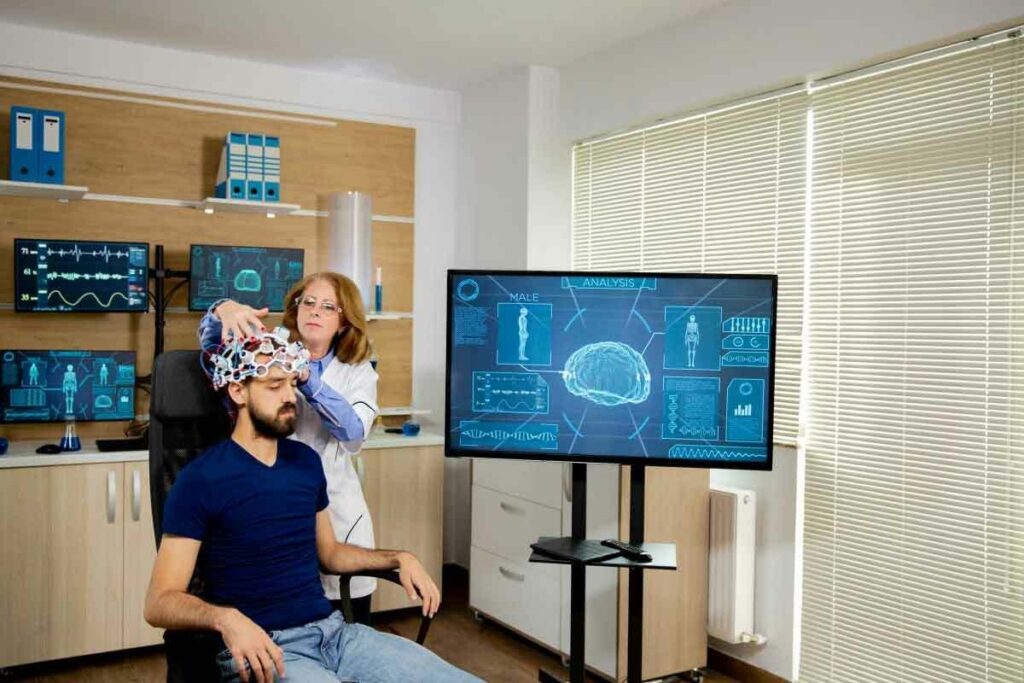Last Updated on October 21, 2025 by mcelik

Every minute is critical when dealing with ischemic stroke. It’s a condition where a blockage in a blood vessel cuts off brain supply. This can lead to severe damage or even death.
At Liv Hospital, we know how urgent and important quick treatment is. We focus on our patients, providing rapid, top-notch care. Our goal is to give the best treatment results for those facing this emergency.

An ischemic stroke occurs when blood flow to the brain is cut off or reduced. This stops brain tissue from getting oxygen and nutrients. It’s a serious medical emergency that needs quick action.
A brain clot stroke, or ischemic stroke, happens when a blood clot blocks a brain blood vessel. This clot can form in the brain (thrombus) or come from elsewhere (embolus).
Clots in brain blood vessels often come from conditions like atherosclerosis or atrial fibrillation. Atherosclerosis is when plaque builds up in arteries. Atrial fibrillation is a heart issue that can cause clots.
Ischemic strokes and hemorrhagic strokes have different causes and effects. Ischemic strokes are caused by a blockage in a blood vessel. Hemorrhagic strokes happen when a blood vessel bursts and bleeds into the brain.
Knowing the difference is key to choosing the right treatment. Most strokes are ischemic, needing treatments to get blood flowing again to the brain.
Ischemic strokes are the most common, making up 87% of all stroke cases. This shows how important it is to know about ischemic stroke causes, symptoms, and treatments.
The high number of ischemic strokes means we need to spread the word about risk factors and prevention.

Understanding how brain blood flow obstruction happens is key. The brain needs a steady blood supply to work right. Any blockage can harm brain tissue.
Keeping the brain healthy needs good blood flow. The brain gets 15% of the heart’s blood, even though it’s only 2% of our body’s weight. It needs oxygen and glucose constantly.
The brain’s blood flow is managed by arteries, veins, and capillaries. This system is complex but vital.
When blood stops reaching the brain, the ischemic cascade starts. This chain of events leads to tissue damage. Without oxygen and glucose, cells can’t make energy.
This lack of energy causes neurons to malfunction. They release chemicals that harm the brain further. Calcium ions and enzymes also play a role in damaging cells.
The ischemic cascade includes several important steps:
The penumbra is brain tissue around the infarct that might be saved. It has less blood flow but not none. This area can be saved if blood flow is restored quickly.
The penumbra is vital in treating ischemic strokes. Quick action can prevent more damage and improve results.
Important points about the penumbra include:
Ischemic stroke happens due to three main reasons that stop blood from reaching the brain. Knowing these causes helps us find better ways to prevent and treat strokes.
Thrombotic strokes happen when a blood clot forms in a brain artery. This clot can block blood flow, causing brain damage because of lack of oxygen and nutrients.
Key factors contributing to thrombotic strokes include:
Embolic strokes occur when a clot forms elsewhere and travels to the brain, blocking an artery.
Common sources of emboli include:
Systemic hypoperfusion is when blood flow drops all over the body. This can lead to not enough blood to the brain, causing an ischemic stroke.
| Cause | Description | Impact on Brain |
| Thrombotic Stroke | Clot forms within brain arteries | Localized damage due to clot obstruction |
| Embolic Stroke | Clot travels from elsewhere in the body | Blockage in narrower arteries supplying the brain |
| Systemic Hypoperfusion | Reduced blood flow throughout the body | Global reduction in cerebral blood flow |
Knowing the main causes of ischemic stroke is key to better treatments and outcomes for patients.
Understanding atherosclerosis is key to grasping ischemic strokes. It affects blood flow to the brain. Atherosclerosis causes plaque buildup in arteries, narrowing and hardening them. This reduces blood flow and raises the risk of blockages that can cause ischemic strokes.
Plaque buildup in arteries is a slow process. It starts with cholesterol and fatty substances on artery walls. Over time, this narrows the artery, cutting off blood flow to vital organs like the brain.
As plaque grows, it can become unstable. This increases the risk of rupture. When an atherosclerotic plaque ruptures, it can block the artery with a blood clot, leading to an ischemic stroke. People with heart conditions are at higher risk.
Not all plaques are the same. Some are more likely to rupture. Vulnerable plaques have a thin cap, a large lipid core, and are inflamed. These traits make them prone to rupture, even with little stress.
When a vulnerable plaque ruptures, it exposes material that causes blood clots. These clots can block the artery or travel to the brain, causing an ischemic stroke.
Atherosclerotic blockages often happen in specific areas. They occur where arteries branch or curve, due to increased blood flow turbulence. This helps plaque build up.
Common blockage sites include the carotid arteries, coronary arteries, and leg arteries. For ischemic stroke, the carotid arteries are critical. They supply most of the brain’s blood.
Cardiac disorders are key in causing ischemic strokes. Some conditions greatly raise the risk of brain clots. The heart and brain are connected through blood vessels. Problems with the heart can badly affect blood flow to the brain.
Atrial fibrillation (AFib) is a heart rhythm problem. It makes the heart beat irregularly and fast. This condition significantly raises the risk of ischemic stroke by causing blood to pool in the heart, leading to clot formation.
The American Heart Association says AFib makes stroke risk five times higher. Managing AFib is vital to prevent strokes and other serious issues.
Other heart problems also raise the risk of ischemic stroke. These include:
Cardioembolic strokes happen when a clot from the heart reaches the brain. This type of stroke is often more severe and deadly. Treatment aims to stop new clots and fix the heart problem.
Effective prevention strategies include using blood thinners to prevent clots. Also, treatments like cardioversion or catheter ablation can help. Closing PFOs in certain patients is another approach.
Several factors can increase your risk of having an ischemic stroke. Knowing these factors is key to preventing and managing strokes. We’ll look at the main risk factors, divided into two groups: those you can change and those you can’t.
Modifiable risk factors are things you can change to lower your stroke risk. These include:
By making lifestyle changes and following medical advice, you can lower your stroke risk.
Non-modifiable risk factors are things you can’t change. These include:
Knowing these non-changeable risk factors helps you focus on managing the ones you can change.
| Risk Factor Category | Specific Risk Factors |
| Modifiable | Hypertension, Diabetes, Smoking, High Cholesterol, Obesity, Physical Inactivity |
| Non-Modifiable | Age, Family History, Genetic Predisposition, Previous Stroke or TIA |
Understanding and managing your risk factors for ischemic stroke is vital. By controlling the factors you can change and knowing the ones you can’t, you can greatly reduce your stroke risk.
Knowing the signs of ischemic stroke is key for quick treatment. We must recognize the warning signs to act fast and effectively in case of a stroke.
The FAST method helps identify stroke symptoms. It stands for Face drooping, Arm weakness, Speech difficulty, and Time to call for emergency services. This method lets us quickly check if someone is having a stroke.
While the FAST method is key, there are other symptoms to watch for. These include sudden confusion, trouble walking, dizziness, loss of balance, and severe headache. Knowing these symptoms helps identify a stroke.
| Symptom | Description |
| Sudden confusion | Difficulty understanding or confusion about their surroundings |
| Trouble walking | Loss of balance or coordination, difficulty walking |
| Dizziness | Feeling dizzy or lightheaded |
| Severe headache | A sudden, severe headache with no known cause |
Transient ischemic attacks (TIAs), or “mini-strokes,” are temporary symptoms like a stroke. A TIA doesn’t cause permanent damage. It’s caused by a temporary decrease in blood supply to part of the brain, lasting as little as five minutes. TIAs are a warning sign of a future stroke, and seeking medical attention is critical.
Symptoms of TIAs are the same as those of a stroke and can include the FAST symptoms, as well as other symptoms like weakness or numbness on one side of the body. If you or someone you know experiences these symptoms, even if they go away, it’s essential to seek medical help.
When someone shows signs of an ischemic stroke, doctors start a quick test to confirm it. They look for the cause to treat it right away. This fast action is key to better care and results.
In the emergency room, we quickly check the patient’s symptoms, medical history, and do a physical exam. This helps us see how bad the stroke is and what tests to do next.
Brain scans are very important for finding ischemic stroke. We use Computed Tomography (CT), Magnetic Resonance Imaging (MRI), and Angiography to see the brain’s blood vessels. These scans help spot blockages or problems.
To find out why the stroke happened, we might do more tests. These include blood tests, electrocardiogram (ECG), and carotid ultrasound.
When an ischemic stroke happens, quick medical help is key to avoid lasting harm. The main goal is to get blood flowing back to the brain. This helps reduce the damage.
The time to act in an ischemic stroke is short. Thrombolytic therapy, a main treatment, works best within 4.5 hours of symptoms starting. This short time frame shows how urgent it is to get medical help fast. The quicker treatment, the better the recovery chances.
Thrombolytic therapy uses medicines to break up the clot causing the stroke. Tissue plasminogen activator (tPA) is the top choice. Given quickly, tPA can greatly help by bringing blood back to the brain.
For big clots or those not good for tPA, mechanical thrombectomy is an option. It removes the clot with special tools. Research shows it can work well to get blood flowing again and improve results.
Along with these treatments, supportive care is also key in the early stages. It includes watching vital signs, controlling blood pressure, and preventing problems like pneumonia or blood clots. Comprehensive supportive care is vital for the best results and sets the stage for successful recovery.
Secondary prevention is key to avoiding more strokes after an ischemic event. It’s vital for the long-term health of those who have had a stroke. Our strategy includes medication, lifestyle changes, and managing risk factors.
Antiplatelet and anticoagulant drugs are essential for stopping future strokes. Antiplatelet drugs like aspirin prevent blood clots. Anticoagulants are best for those with atrial fibrillation or other heart issues.
Choosing the right medication depends on the stroke cause, patient risk, and bleeding concerns. We tailor treatment to each patient’s needs.
Controlling blood pressure and cholesterol is vital for stroke prevention. Hypertension is a big risk factor. We use lifestyle changes and meds to manage it. Cholesterol control through diet and statins also helps prevent strokes.
We regularly check and adjust treatment to keep blood pressure and cholesterol in check.
Lifestyle changes are key for stroke survivors. We suggest a healthy diet and regular exercise. These help improve health and lower stroke risk.
We also push for quitting smoking and cutting down on alcohol. These changes can greatly reduce the chance of another stroke.
The journey to recovery after an ischemic stroke is complex. It involves many therapies to help regain lost functions. Rehabilitation is key, helping patients become independent again and improve their life quality.
Rehabilitation after an ischemic stroke includes physical, occupational, and speech therapies. Physical therapy works on improving mobility, strength, and balance. Occupational therapy helps with daily living skills and independence. Speech therapy focuses on communication and swallowing issues.
These therapies are customized for each patient. A team of healthcare professionals creates a detailed rehabilitation plan.
| Therapy Type | Focus | Goals |
| Physical Therapy | Improving mobility, strength, and balance | Regaining physical function, reducing disability |
| Occupational Therapy | Regaining skills for daily living | Achieving independence in daily activities |
| Speech Therapy | Addressing communication and swallowing disorders | Improving communication, reducing risk of aspiration |
Neuroplasticity is vital for recovery from ischemic stroke. It allows the brain to adapt and change. Through neuroplasticity, the brain can form new connections and compensate for damaged areas.
“The brain’s ability to reorganize itself in response to injury is a key factor in recovery from stroke. By harnessing neuroplasticity, rehabilitation therapies can help patients regain lost functions.”
Setting realistic goals and managing expectations are key in rehabilitation. Patients and their families should work with their healthcare team. Together, they can set achievable goals and understand the recovery process.
Recovery from ischemic stroke is a slow process. It requires patience, motivation, and support. By understanding the rehabilitation process and setting realistic goals, patients can make the most of their recovery.
Recent years have seen big improvements in treating ischemic stroke. Better ways to diagnose and treat strokes have made a big difference. Treatments like thrombolytic therapy and mechanical thrombectomy have changed how we handle strokes, including cva thrombosis and brain clot stroke.
Looking ahead, we need to keep researching and finding new ways to help patients. New technologies and treatments could make caring for stroke patients even better. By building on what we know and exploring new ideas, we can help reduce the number of strokes and their effects.
We’re committed to providing top-notch healthcare and support to patients worldwide. Our goal is to make a real difference in the lives of those affected by stroke.
An ischemic stroke happens when a blood clot blocks a brain blood vessel. This cuts off blood and oxygen to part of the brain.
An ischemic stroke is caused by a blood clot. A hemorrhagic stroke is caused by bleeding in or around the brain.
Symptoms include sudden weakness or numbness in the face, arm, or leg. You might also have trouble speaking or understanding speech. Sudden vision changes, dizziness, or loss of balance are other signs.
The FAST method helps spot stroke symptoms. Face (check for drooping), Arm (check for weakness), Speech (check for slurring), and Time (call for emergency services immediately).
A TIA, or “mini-stroke,” is when brain blood supply is briefly interrupted. It’s often a warning sign for a future stroke.
Main causes include thrombotic strokes (clots in brain arteries) and embolic strokes (clots from elsewhere). Systemic hypoperfusion is another cause.
Doctors use physical exams, medical history, and tests like brain imaging. They check for the cause of the stroke.
Treatment includes clot-busting medications and mechanical thrombectomy. Supportive care is also given to reduce brain damage.
These medications prevent more clots and lower stroke risk in patients who’ve had an ischemic stroke.
Eating well, exercising, managing blood pressure and cholesterol, and quitting smoking can lower stroke risk.
Neuroplasticity is the brain’s ability to adapt and recover. It’s key in the rehabilitation and recovery of stroke patients.
Rehabilitation helps patients regain lost functions. It includes physical, occupational, and speech therapy for the best recovery.
A brain clot stroke, or ischemic stroke, happens when a blood clot blocks a brain blood vessel. This cuts off blood and oxygen to part of the brain.
Ischemic stroke is when a blood clot or thrombus blocks a brain blood vessel. ‘Schemic stroke’ is a misspelling of this term.
Ischemic CVA (cerebrovascular accident) is another term for an ischemic stroke. It occurs when a blood clot or thrombus blocks a brain blood vessel.
Subscribe to our e-newsletter to stay informed about the latest innovations in the world of health and exclusive offers!
WhatsApp us